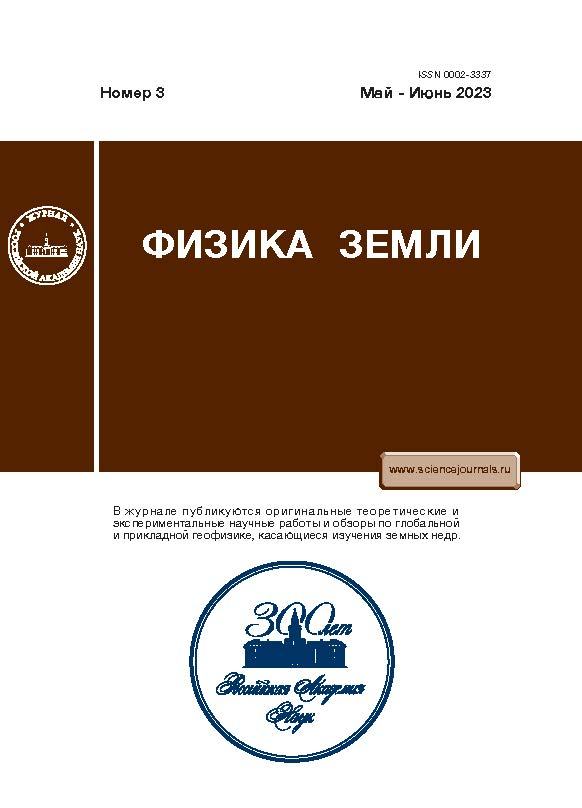Numerical Simulation of Material Ejection into the Atmosphere Induced by Oblique Impacts of Ten-Kilometer-Diameter Asteroids into the Ocean
- Autores: Shuvalov V.V.1
-
Afiliações:
- Sadovsky Institute of Geosphere Dynamics, Russian Academy of Sciences
- Edição: Nº 3 (2023)
- Páginas: 131-138
- Seção: Articles
- URL: https://journals.eco-vector.com/0002-3337/article/view/658120
- DOI: https://doi.org/10.31857/S0002333723030122
- EDN: https://elibrary.ru/KBCVUQ
- ID: 658120
Citar
Texto integral
Resumo
The results of a three-dimensional numerical simulation of the oblique impacts of ten-kilometer asteroids at an angle of 45° onto a solid surface and into an ocean with a depth of 1 to 6 km are presented. The maximum masses of water, impactor, and soil ejected into the atmosphere and the masses of water, impactor material, and soil remaining in the atmosphere 10 minutes after the impact are calculated. The mass of vaporized ejecta is determined. It is shown that there are 2–5 times more impactor material and soil ejected into the atmosphere during oblique impacts than during vertical impacts.
Palavras-chave
Sobre autores
V. Shuvalov
Sadovsky Institute of Geosphere Dynamics, Russian Academy of Sciences
Autor responsável pela correspondência
Email: valeryvshuvalov@gmail.com
119334 Russia, Moscow
Bibliografia
- Кузнецов Н.М. Термодинамические функции и ударные адиабаты воздуха при высоких температурах. М.: Машиностроение. 1965. 463 с.
- Шувалов В.В., Хазинс В.М. Численное моделирование возмущений в ионосфере, генерируемых при падении Челябинского и Тунгусского космических тел // Астрономический Вестник. 2018. Т. 52. № 2. С. 142–151.
- Шувалов В.В. Выброс вещества в атмосферу при падении десятикилометровых астероидов в океан // Астрономический Вестник. 2021. Т. 55. № 2. С. 114–123.
- Artemieva N., Morgan J. Modeling the formation of the k-pg boundary layer // Icarus. 2009. V. 201. № 2. P. 768–780.
- Alvarez L.W., Alvarez W., Asaro F., Michel H.V. Extraterrestrial cause for the Cretaceous–Tertiary extinction // Science. 1980. V. 208. P. 1095–1108.
- Claeys P. Impact events and the evolution of the Earth. // Advances in Astrobiology and Biogeophysics, Lectures in Astrobiology / M. Gargaud, H. Martin, P. Claeys (eds.). Berlin: Springer Verlag. 2007. P. 239–280.
- Feulner G. Limits to biodiversity cycles from a unified model of mass−extinction events // International Journal of Astrobiology. 2011. V. 10. P. 123–129.
- Hildebran A.R., Penfield G.T., Kring D.A., Pilkington M., Camargo–Zanoguera A., Jacobsen S.B., Boynton W.V. Chicxulub crater. A possible Cretaceous-Tertiary Boundary impact crater on the Yucatan peninsula, Mexico // Geology. 1991. V. 19. P. 867–871.
- Kring D.A. The Chicxulub impact event and its environmental conse quences at the Cretaceous–Tertiary boundary // Palaeogeography, Palaeoclimatology, Palaeoecology. 2007. V. P. 255: 4–21.
- Pierazzo E., Garsia R.R., Kinnison D.E., Marsh D.R., Lee-Taylor J., Crutzen P.J. Ozone perturbation from medium-size asteroid impacts in the ocean // Earth and Planetary Science Letters. 2012. V. 229. P. 263–272.
- Rampino M.R. Relationship between impact-crater size and severity of related extinction episodes // Earth-Science Rev. 2020. V. 201. P. 102990.
- Shuvalov V.V. Multi-dimensional hydrodynamic code SOVA for interfacial flows: Application to thermal layer effect // Shock Waves. 1999. V. 9. № 6. P. 381–390.
- Shuvalov V., Dypvik H. Ejecta formation and crater development of the Mjolnir impact // Meteoritics & Planetary Science. 2004. V. 39. № 3. P. 467–479.
- Thompson S.L., Lauson H.S. Improvements in the Chart D radiation-hydrodynamic CODE III: Revised analytic equations of state. Report SC-RR-71 0714. Albuquerque: Sandia National Laboratory. 1972. 119 p.
- Wunnemann K., Ivanov B.A. Numerical modeling of the impact crater depth-diameter dependence in an acoustically fluidized target // Planetary Space Science. 2003. V. 51. P. 831– 845.
Arquivos suplementares














